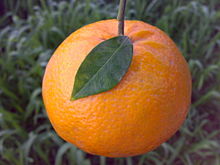Kinnow
| Kinnow | |
|---|---|

Kinnow, Courtesy by SMHT
|
|
| Hybrid parentage | 'King' (Citrus nobilis) × 'Willow Leaf' (Citrus × deliciosa) |
| Breeder | Howard B. Frost, University of California Citrus Experiment Station in 1935 |
The kinnow is a high yield mandarin hybrid cultivated extensively in the wider Punjab region of Pakistan and India .
It is a hybrid of two citrus cultivars — 'King' (Citrus nobilis) × 'Willow Leaf' (Citrus × deliciosa) — first developed by Howard B. Frost, at the University of California Citrus Experiment Station. After evaluation, the 'kinnow' was released as a new citrus hybrid for commercial cultivation in 1935.
In a hot climate, plants can grow up to 35 feet high. 'Kinnow' trees are highly productive; it is not uncommon to find 1000 fruits per tree.
The fruit matures in January or February. It peels easily and has a high juice content.
The high seed content in this variety is a major hindrance in out-of-hand eating. University of California, Riverside, USA developed low seeded 'Kinnow' and released it under the name 'Kinnow LS' in the year 2011. Punjab Agricultural University, Ludhiana, India also developed low seeded 'Kinnow' through mutation breeding and recommended it under the name 'PAU Kinnow' in the year 2015. In Pakistan, a seedless 'kinnow' has been developed (using selection method) by Niaz Ahmad Chaudhry '[1][2]', a team member of National Agricultural Research Centre (NARC), Islamabad 'NARC' (former director of Citrus Research Institute (CRI), Sargodha,'CRI'. The seedless variety has achieved a higher production level from the Western Mediterranean countries of Spain and Morocco.
...
Wikipedia
